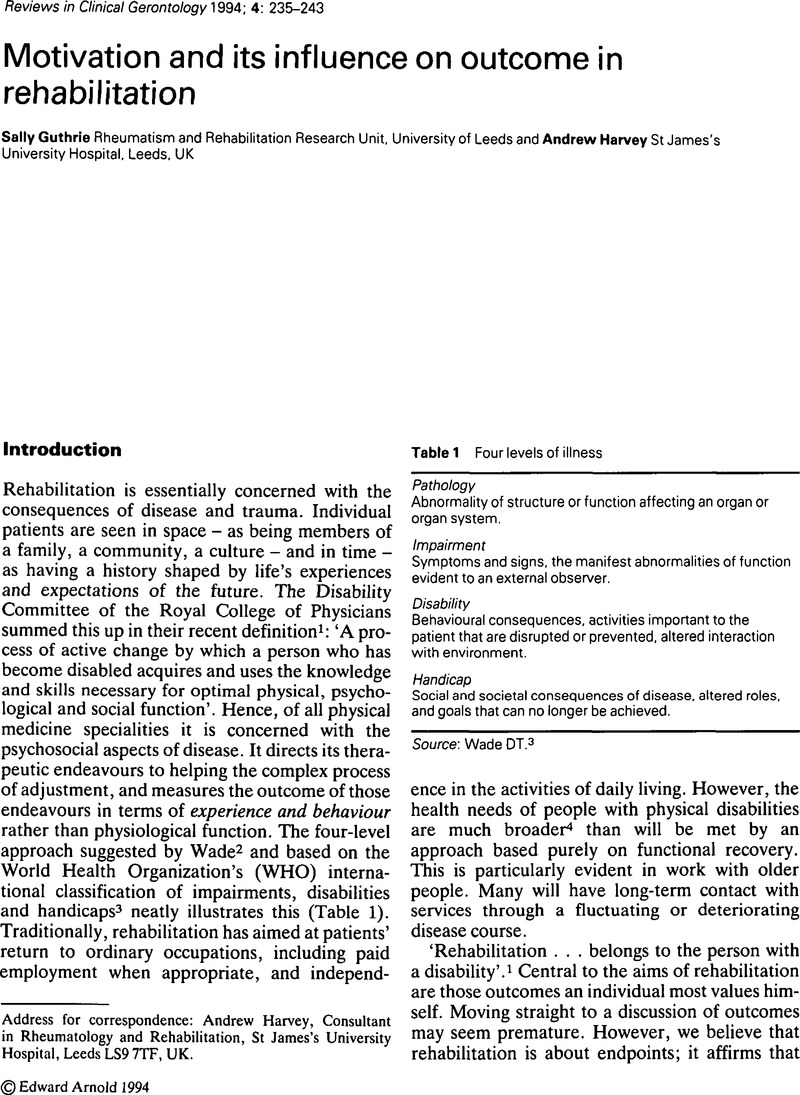Crossref Citations
This article has been cited by the following publications. This list is generated based on data provided by Crossref.
Nolan, Mike
and
Nolan, Janet
1997.
Rehabilitation: realizing the potential nursing contribution.
British Journal of Nursing,
Vol. 6,
Issue. 20,
p.
1176.
Rockwood, Kenneth
Silvius, James L.
and
Fox, Roy A.
1998.
Comprehensive geriatric assessment.
Postgraduate Medicine,
Vol. 103,
Issue. 3,
p.
247.
Heim, M.
Wershavski, M.
Arazi-Margalit, D.
and
Azaria, M.
1998.
The will to walk—a partnership involving dual dynamics.
Disability and Rehabilitation,
Vol. 20,
Issue. 2,
p.
74.
Tesch-Römer, Clemens
and
Wahl, Hans-Werner
1998.
Comprehensive Clinical Psychology.
p.
525.
Nolan, M.R.
1998.
Outcomes and effectiveness: beyond a professional perspective.
Clinical Effectiveness in Nursing,
Vol. 2,
Issue. 2,
p.
57.
Stolee, Paul
Zaza, Christine
Pedlar, Alison
and
Myers, Anita M.
1999.
Clinical Experience with Goal Attainment Scaling in Geriatric Care.
Journal of Aging and Health,
Vol. 11,
Issue. 1,
p.
96.
Koenig, Harold G.
George, Linda K.
Larson, David B.
McCullough, Michael E.
Branch, Patricia S.
and
Kuchibhatla, Maragatha
1999.
Depressive Symptoms and Nine-Year Survival of 1,001 Male Veterans Hospitalized With Medical Illness.
The American Journal of Geriatric Psychiatry,
Vol. 7,
Issue. 2,
p.
124.
Hurn, Jane
Kneebone, Ian
and
Cropley, Mark
2006.
Goal setting as an outcome measure: a systematic review.
Clinical Rehabilitation,
Vol. 20,
Issue. 9,
p.
756.
Booth, Steve
and
Jester, Rebecca
2007.
Advancing Practice in Rehabilitation Nursing.
p.
1.
Playford, Diane
2008.
Outcome measurement in neurological disease.
Current Opinion in Neurology,
Vol. 21,
Issue. 6,
p.
649.
Chang, Yung-Yun
Peng, Li-Ning
Lin, Ming-Hsien
Lai, Hsiu-Yun
Chen, Liang-Kung
Hwang, Shinn-Jang
and
Lan, Chung-Fu
2011.
Who determines the rehabilitation needs of care home residents?.
Archives of Gerontology and Geriatrics,
Vol. 52,
Issue. 2,
p.
138.
Watts, Michael
and
Finucane, Paul
2012.
Pathy's Principles and Practice of Geriatric Medicine.
p.
1395.
Barrett, N
Swain, I
Gatzidis, C
and
Mecheraoui, C
2016.
The use and effect of video game design theory in the creation of game-based systems for upper limb stroke rehabilitation.
Journal of Rehabilitation and Assistive Technologies Engineering,
Vol. 3,
Issue. ,
Mpofu, Elias
Athanasou, James
Craig, Ashley
and
Heasley, Shane
2018.
Disability and Vocational Rehabilitation in Rural Settings.
p.
335.
Specht, Kirsten
Agerskov, Hanne
Kjaersgaard-Andersen, Per
Jester, Rebecca
and
Pedersen, Birthe D.
2018.
Patients’ experiences during the first 12 weeks after discharge in fast-track hip and knee arthroplasty – a qualitative study.
International Journal of Orthopaedic and Trauma Nursing,
Vol. 31,
Issue. ,
p.
13.
Vourganas, Ioannis
Stankovic, Vladimir
Stankovic, Lina
and
Kerr, Andrew
2019.
Factors That Contribute to the Use of Stroke Self-Rehabilitation Technologies: A Review.
JMIR Biomedical Engineering,
Vol. 4,
Issue. 1,
p.
e13732.
Inui, Yasuhiro
Ogawa, Tatsuya
Tanaka, Yoichi
Hayashida, Kazuki
and
Morioka, Shu
2022.
Relationship between exercise motivation and social support in a support facility for persons with disabilities in Japan.
Annals of Medicine,
Vol. 54,
Issue. 1,
p.
820.
Jablonski, Megan E.
and
Lange, Adrianne E.
2022.
Functional Movement Disorder.
p.
415.
Corey, Matthew T.
2022.
Pathy's Principles and Practice of Geriatric Medicine.
p.
1249.
Tan, Alexander W. T.
Yeo, Y. H.
Tay, J. Y.
Nur-Akasyah, J.
Ripin, Z. M.
Razali, M. F.
and
Ridzwan, M. I. Z.
2023.
Development of custom-made serious game for trunk post-stroke rehabilitation.
Vol. 2959,
Issue. ,
p.
080003.



